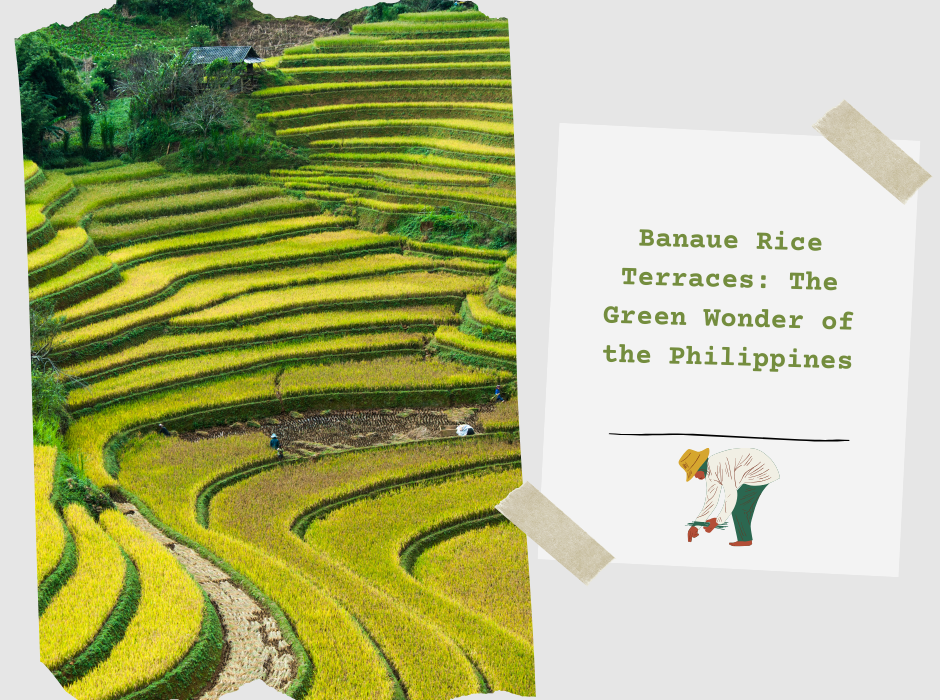Among the natural beauties of the Philippines, few sights compare to the breathtaking view of the Banaue Rice Terraces. These more than 2,000-year-old, hand-built terraces are not only the foundation of local agriculture but also an essential part of Filipino culture and history. Created using ancient agricultural techniques by the Ifugao people, the terraces wind along the mountainsides like green stairways to the sky, and are often considered the eighth wonder of the world. In this blog post, we’ll explore the beauty and significance of this unique place.

The terraces, which rise to about 5,000 feet above sea level, were primarily carved by hand with stone and earth walls that follow the natural contours of the mountains. The ancient techniques used in the construction and maintenance of the terraces are still applied today, carrying forward the knowledge and experience of generations. This impressive feat was essential, as the highlands left the Igorot people with few options for flat, fertile land. As a result, the terraces allowed for rice cultivation, with the Ifugao people ingeniously using natural waterways and springs for irrigation, making rice farming possible even on steep slopes. The terraces were designed to ensure each step receives an optimal amount of water, allowing the flooded rice fields to thrive.

While the Banaue terraces are not the only rice terraces in the world, with many others found across Asia, there are several reasons why the Banaue Rice Terraces of the Philippines are a must-see:
- Known as one of the world’s eight wonders
- Spans an area of over 10,300 square kilometers
- A national cultural treasure
- A 2,000-year-old marvel
- Part of the UNESCO World Heritage Sites
Discovering the terraces involves hiking, where trails winding through the mountainsides allow you to admire the view, surrounded by fresh air and the peace of nature.
Tip: You can also visit the rice fields on an organized tour:
The Ifugao people offer guided tours, where you can gain deeper insights into the terraces’ history, local life, and the traditional agricultural techniques that have endured through the ages. Be sure to visit the Tam-An Cultural Village, which, although not easily accessible, is worth every step. Upon entering the village, it feels as if time stands still. The houses, built of bamboo and straw, fit perfectly into the environment.

The locals are proud of their culture and are happy to share their customs, handcrafted products, and agricultural techniques with visitors. Life here is simple and peaceful, yet incredibly rich.

Savor these moments, and make them even more memorable by trying out the following recommended activities:
• Spend at least one night in an Ifugao hut

• Don’t miss Ifugao coffee: Ifugao coffee is grown on the steep slopes of the Cordillera Mountains in the northern Philippines. The region is famous for its traditional rice terraces, but coffee farming is also deeply rooted in local culture. The high altitude and cool climate provide ideal conditions for ARABICA coffee plants. The unique flavor of Ifugao coffee comes from the environmental characteristics of the region. The coffee beans here often carry rich fruity and floral notes, with a slightly chocolatey and nutty aftertaste.
• Taste native rice wine: Rice wine production is deeply embedded in local culture. Tapuy is made from sticky rice, which is first cooked and then left to ferment. The fermentation process is natural and often involves traditional methods like wrapping in banana leaves, giving the drink its unique taste and aroma.
• Try local dishes like pinikpikan and other traditional delicacies: The preparation of pinikpikan is a unique process rooted in local traditions. The chicken is gently but firmly beaten with a stick so the blood flows into the meat, enhancing its flavor. The chicken is then cut and often cooked as a simple soup seasoned with salt, pepper, ginger, and sometimes vegetables.

Information and Tips
• Activities and routes in Banaue require a lot of walking, hiking, and trekking, so being physically prepared is recommended.
• The mobile signal is very weak, sometimes nonexistent, so make sure you’re not dependent on your phone for work or urgent matters.
• Be sure to visit the Banaue Tourism Office to pay the tourism fee and register.
• Always join a guided tour; never venture out on your own, as you could get lost.
• Bring suitable clothing for hiking and cold weather.
• Purchase locally made souvenirs to support the community.
Tip: Bring enough cash, as there are no available ATMs.
Extra Tip: Not only for Victoria Residential Ship passengers, but it’s essential to know that everything here is cash-only. Restaurants do not accept credit cards, so be sure to exchange cash in Manila.
Indeed, Banaue is a paradise in its own way, a place of exceptional happiness and joy. A place where you can be one with nature. A place that encourages you to be fully present. A place that offers a glimpse into a rich culture maintained by younger generations. The Banaue Rice Terraces are among the Philippines’ most unique and valuable natural wonders.


